- Bauhaus Interior Design: Why This 100-Year-Old Style Still Works Today - September 6, 2025
- Southwestern Interior Design: What I Wish I’d Known 20 Years Ago - September 6, 2025
- Why Norwegian Interior Design Actually Makes Your Home Feel Like Home - September 4, 2025
Table of Contents
Manchester, 2009. Standing in what used to be a textile mill, listening to my client say “Whatever you do, don’t paint those brick walls.” I thought she was crazy. Sixteen years later, I realize that project taught me everything about what makes industrial design actually work. People throw around the term “industrial style” like it’s just another Pinterest trend, but real industrial design comes from necessity, not decoration. When creative folks started converting abandoned factories into homes after World War II, they weren’t trying to make a style statement. They were working with what they had: concrete floors, exposed pipes, steel beams, brick walls that had seen decades of use. Nobody planned for these spaces to be beautiful. They just were.
Why Most “Industrial” Design Fails
You know those furniture stores selling “industrial farmhouse” everything? The fake rust finishes and perfectly distressed metal made to look old? That’s not industrial design, it’s industrial cosplay. Real industrial pieces have stories. My favorite coffee table started life as a factory cart in Detroit. The paint’s chipping off, one wheel squeaks, and guests always end up rolling it around during dinner parties. You can’t manufacture that kind of character.
Authentic materials age differently than reproductions. Genuine reclaimed wood develops this incredible patina over time, where the scratches and dings aren’t flaws – they’re history. Steel that’s actually been used has this warm, worn quality that new metal trying to look old never achieves. I’ve seen too many spaces that look like industrial theme restaurants, all Edison bulbs and fake vintage signs, but no soul. Industrial design works because it’s honest, not because it follows a checklist of trendy elements.
Materials That Matter (And Why)
Brick walls drive me nuts sometimes because clients want to “fix” them – clean off the old mortar, make everything uniform. Don’t. Good brick has personality with color variations, a bit of crumbling here and there, maybe some old paint that won’t budge. Perfect brick looks fake because perfect brick is fake. I use concrete differently depending on what story I want the space to tell. Sometimes I polish it until you can see your reflection. Other times I leave every mark from the wooden forms that shaped it. Both approaches work, but they create completely different feelings.
Steel elements should never apologize for being steel. Exposed beams, metal window frames, iron pipe fixtures – they’re beautiful because they do their job honestly. The moment you start disguising structural elements is the moment you lose what makes industrial design special. Color gets misunderstood constantly too. Everyone thinks industrial means gray and black only, but some of my most successful projects include deep navy blues, forest greens, even burgundy. The difference is choosing colors that feel substantial rather than decorative.
Benjamin Moore’s “Wrought Iron” works magic with red brick, and “Chelsea Gray” softens concrete without killing the industrial vibe. But I’ve also used rich jewel tones as accent walls – it’s about balance, not following rigid rules that don’t exist anyway.
Room by Room Reality Check
Living Rooms That Actually Work
Forget delicate fabrics and precious furniture. Industrial living spaces need pieces that can handle real life, and leather ages beautifully in these environments – it gets better with wear rather than looking shabby. I hunt for vintage pieces with actual history like factory stools, old office chairs, machinery repurposed as tables. Each piece should feel like you found it somewhere interesting, not like you bought a matching set at a chain store.
Textiles add necessary warmth, but choose carefully. Canvas curtains instead of silk, wool rugs that can handle foot traffic. Everything should feel sturdy and real, not like it needs to be protected from daily life. The goal is creating a space that invites you to actually use it, not admire it from a distance.
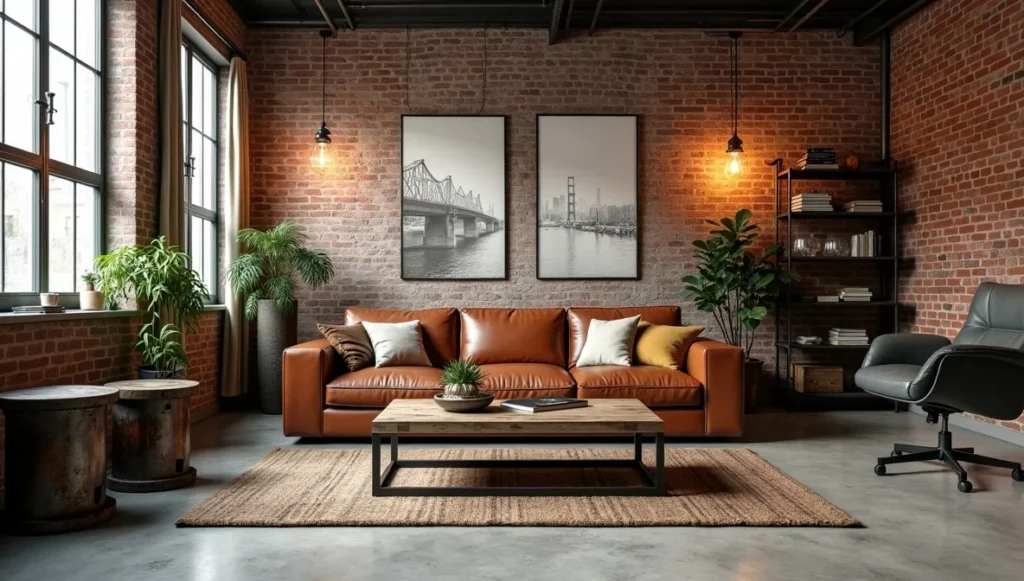
Kitchens Where Cooking Happens
Industrial kitchens celebrate food preparation rather than hiding it. Open shelving displays your actual dishes and tools like equipment in a working kitchen, and heavy steel brackets supporting thick wood shelves can hold cast iron pans and stand mixer collections without sagging. Concrete countertops aren’t maintenance-free, they can stain and need periodic sealing, but when they develop that lived-in patina, they’re absolutely gorgeous. Stainless steel sections around work areas bridge residential comfort with commercial functionality.
Lighting scale matters enormously in these spaces. Small pendants get swallowed by large volumes, so I’ve hung vintage factory lights, custom pieces made from salvaged materials, even repurposed ship fixtures. Each choice dramatically changes how the space feels and functions.
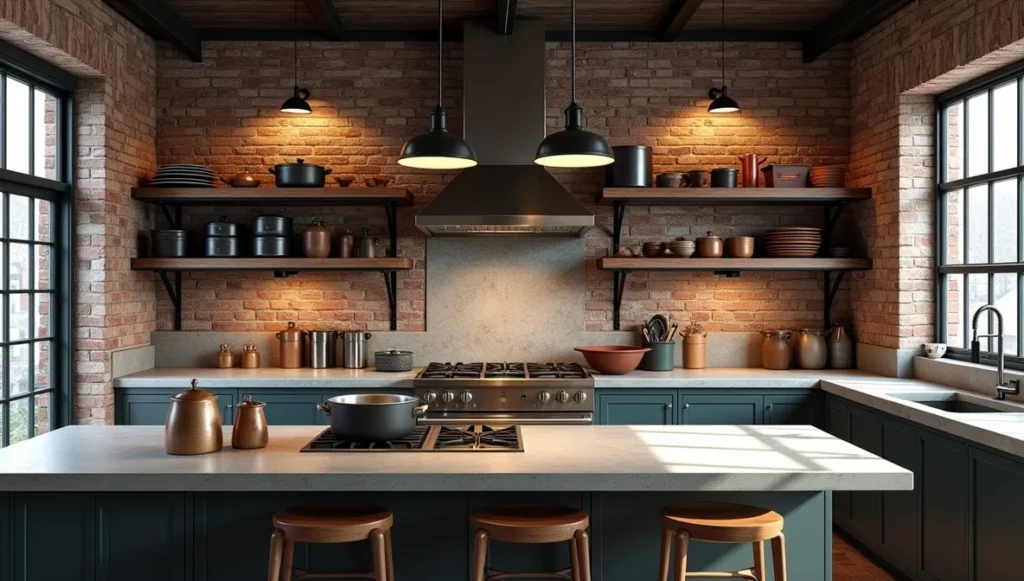
Bedrooms Without the Warehouse Chill
Metal bed frames need substance or they look flimsy and uncomfortable. I often build custom headboards using reclaimed wood planks on steel frames, which gives you warmth and industrial edge without going full prison cell. Storage becomes decorative when you choose right, pick vintage lockers, metal armoires, even old factory equipment can replace traditional closets. The goal is finding pieces that earned their character rather than having it applied in a factory.
Bedside lighting needs flexibility too. Wall-mounted swing-arm lamps free up nightstand space while giving you both task and ambient lighting options. Skip the matching table lamp pairs…after all, this isn’t a hotel chain, and symmetry isn’t required for good industrial design.
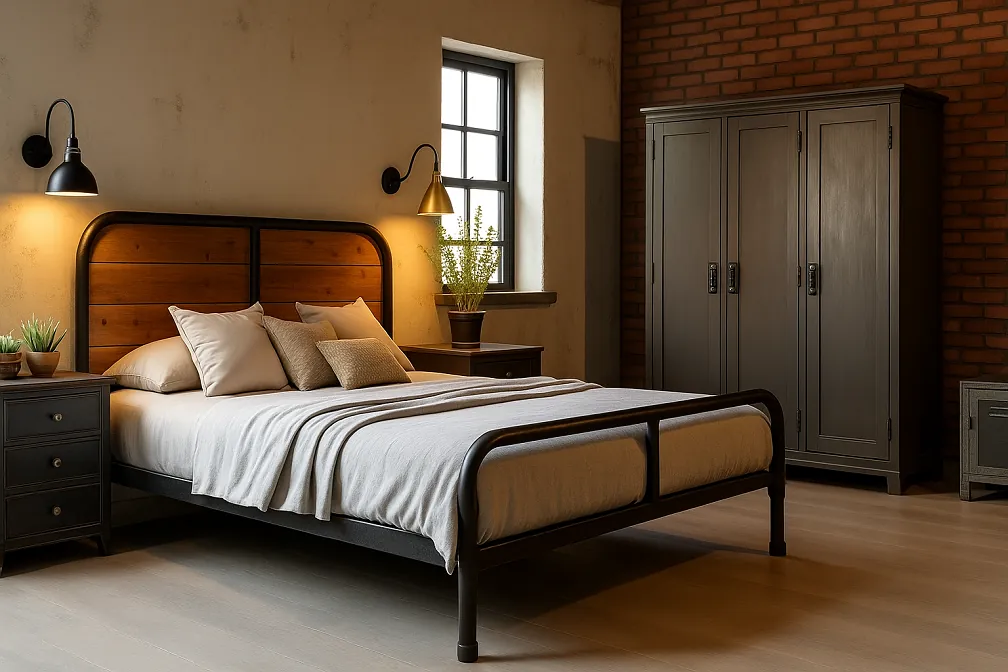
Bathrooms That Feel Like Spas
Concrete vessel sinks on wood vanities create amazing focal points, and exposed plumbing becomes sculptural with quality fixtures rather than looking unfinished. Walk-in showers with concrete walls and steel details feel luxurious, not institutional, when executed thoughtfully. The challenge is softening all those hard surfaces enough to feel comfortable rather than punishing. Good lighting, quality textiles, and strategic wood elements make the difference between industrial chic and industrial punishment.
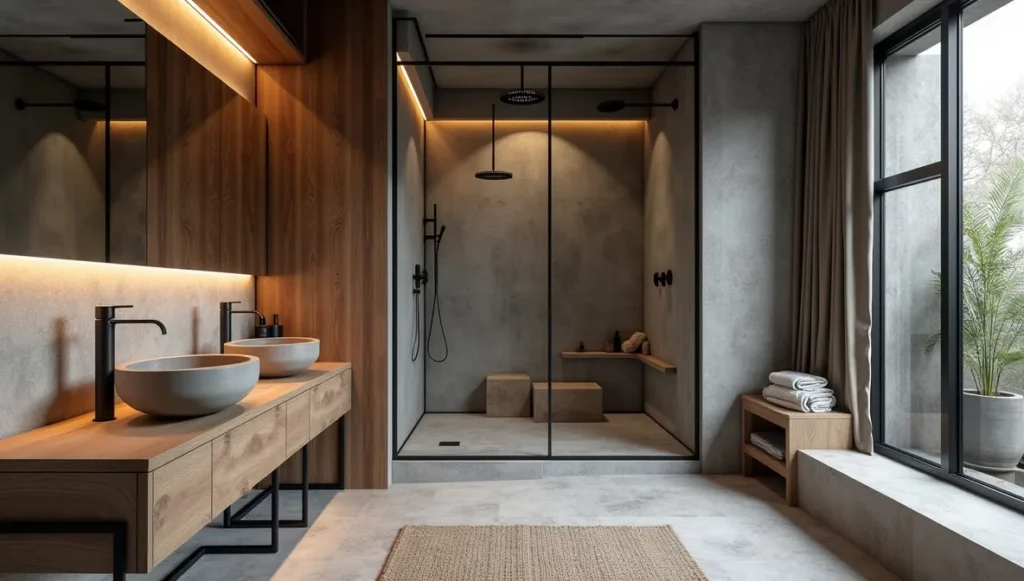
Home Offices That Mean Business
I’ve built dozens of home offices, and industrial elements solve problems other styles can’t touch. A thick wood slab on steel pipe legs gives you a desk that won’t shake when you’re typing furiously or wobble under the weight of multiple monitors. Simple steel brackets holding reclaimed wood shelves cost less than fancy modular systems and look infinitely better.
Lighting makes or breaks these spaces. I hunt for vintage articulating lamps – the kind factories used for precision work. They’re built to last and give you real control over where light goes. Those trendy Edison bulbs everyone loves? Useless for actual work. Save them for the living room.
Storage gets interesting when you stop hiding everything. Old metal filing cabinets, industrial shelving, even repurposed factory bins work better than built-ins that cost twice as much. Your office should look like someone who takes their work seriously uses it, not like a showroom nobody touches.
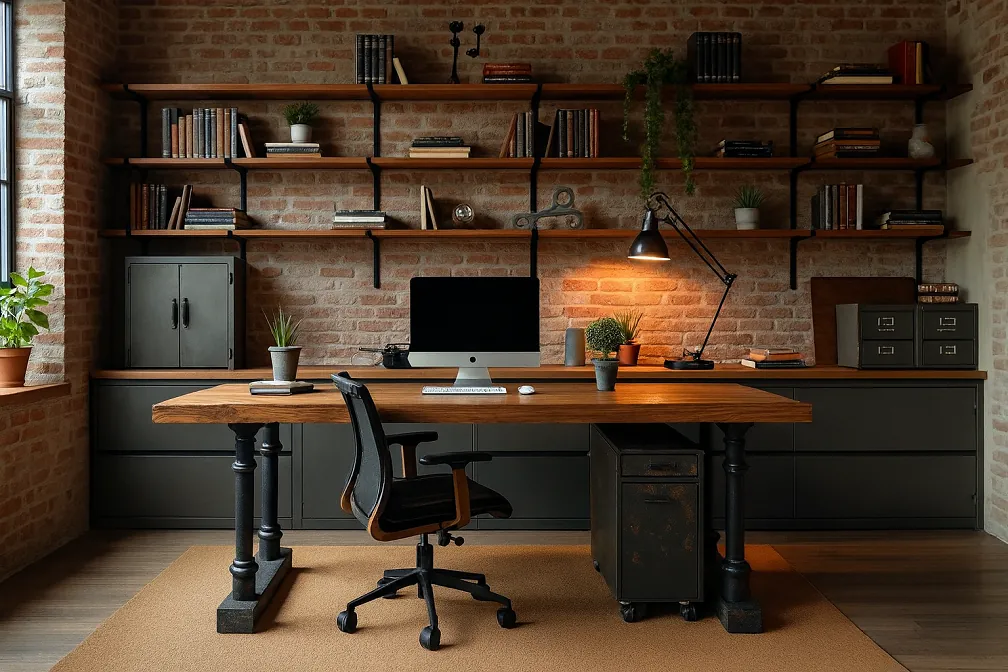
Common Disasters to Avoid
The Theme Park Problem
Slapping Edison bulbs and fake vintage signs everywhere doesn’t create industrial design, rather, it creates a parody! If your building doesn’t have exposed brick, don’t fake it with wallpaper. If your ceilings aren’t high enough for dramatic lighting, work with your actual architecture instead of fighting it. Authenticity beats completeness every time, and a few genuine pieces look infinitely better than a room full of industrial-style reproductions.
Forgetting People Actually Live There
All those hard surfaces create echo chambers where conversations become difficult and footsteps sound like thunderclaps. Strategic rugs, some upholstered furniture, even wall hangings solve acoustic problems without destroying the aesthetic. Temperature matters too – concrete floors feel brutal in winter, so radiant heating helps, or at least area rugs where people walk barefoot. Steel conducts cold efficiently, so consider placement carefully near windows and exterior walls.
Why This Style Sticks Around
Industrial design endures because it’s based on function rather than fashion. The materials are real, the construction is visible, the history is authentic. In our world of disposable everything, these qualities feel increasingly valuable and meaningful. The style adapts to different contexts better than most people think too. I’ve used industrial elements successfully in suburban ranch houses, urban apartments, even traditional colonials. Success comes from choosing appropriate elements rather than forcing complete transformations that fight against existing architecture.
Sustainability plays a bigger role than most people realize. Industrial design celebrates reuse and repurposing over buying new manufactured goods. That reclaimed wood table isn’t just beautiful, it’s also keeping old-growth timber out of landfills. Salvaged materials prevent new resource extraction while bringing genuine history into contemporary spaces.
Making It Personal
The best industrial spaces feel collected over time rather than decorated all at once. Each piece should have a story, whether it’s a genuine vintage find or contemporary work chosen for honest construction and quality materials. Don’t rush this process because real character develops as you find the right pieces and learn how different materials interact in your specific space. The goal isn’t magazine perfection, it’s creating a space that reflects how you actually live and what you value.
Industrial design connects us to the physical world in our increasingly digital times. The weight of steel, texture of worn brick, patina on aged copper – these sensory experiences ground us in ways that smooth, perfect surfaces simply can’t match. Whether you’re working with an actual warehouse conversion or adding industrial elements to a conventional home, remember that authenticity trumps completeness every single time. Start with one or two genuine pieces and build from there thoughtfully.
This isn’t about following rules or checking boxes off some design list. It’s about understanding materials, respecting craftsmanship, and creating spaces that feel honest about their purpose and history. Get that foundation right, and everything else falls into place naturally. Industrial design works because it doesn’t try to be anything other than what it is – functional, honest, and beautiful in its refusal to apologize for showing its age and purpose.
